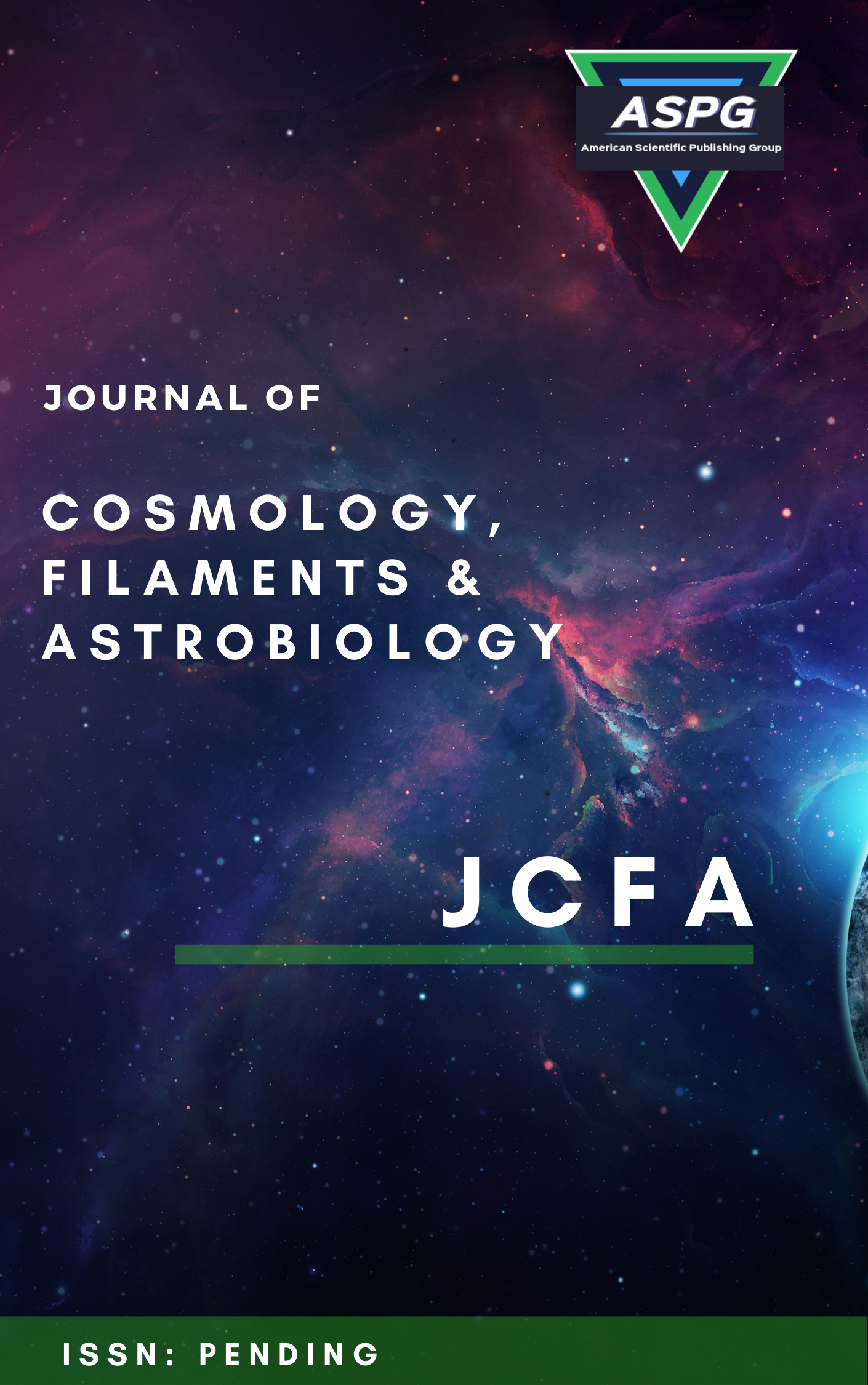

Volume 2 , Issue 2 , PP: 13-21, 2023 | Cite this article as | XML | Html | PDF | Full Length Article
Victor Christianto 1 * , Yunita Umniyati 2
Doi: https://doi.org/10.54216/JCFA.020203
In the well-known Aharonov-Bohm effect, a charged particle experiences a phase shift as it moves through a region of space where the magnetic field is zero. The presence of a magnetic flux in the area, which influences the wave function of the particle, results in this phase shift. The Aharonov-type interaction, in which the phase shift is caused by a topological flaw in the system, such as a spin texture or a Berry phase, rather than a magnetic field, has attracted increasing interest in recent years. In this regards, in a recent paper, we argued in favour of Gross-Pitaevskii model as a more complete description of both solar system and spiral galaxies, especially taking into account the nature of chirality and vortices in galaxies (see Prespacetime J, 2021, & SMIC, 2020). In this paper, we will discuss shortly a nonlinear cosmology model inspired by analogy between cosmology phenomena and low temperature physics, especially via superconductor / superfluid vortices dynamics. We described: (a) a nonlinear cosmology model based on Navier-Stokes turbulence equations, which then they are connected to superfluid turbulence, and (b) the superfluid turbulence can lead to superfluid quantized vortices, which can be viewed as large scale version of Bohr’s quantization rule, and (c) this superfluid quantized vortice interpretation of Bohr’s rule allow us to predict quantization of planetary orbits in solar system including new possible orbits beyond Pluto. In more specific way. we apply the new model based on Bogoliubov-de Gennes equation correspondence with Bohr-Sommerfeld quantization rules. Then we put forth an argument that from Bohr-Sommerfeld quantization rules we can come up with a model of quantized orbits of planets in our solar system, be it for inner planets and also for Jovian planets. In effect we also tried to explain Sedna’s orbit in the same scheme.
Condensed Matter , Superconductor Model , Solar System , Aharonov-Bohm effect
[1] Christianto V. A Cantorian superfluid vortex and the quantization of planetary motion. Apeiron. 2004;11(1):112-52.
[2] Christianto V, Smarandache F. On the possibility of binary companion of the Sun. Prespacetime J. 2020;11(1):
[3] Christianto V, Smarandache F, Umniyati Y. Towards Gross-Pitaevskiian Description of Solar System and Galaxies. Prespacetime J. 2020;11(3):
[4] Sonin E B. Dynamics of quantized vortices in superfluids. Cambridge: Cambridge University Press; 2016.
[5] Huang K. A superfluid Universe. Singapore: World Scientific Publishing Co. Pte. Ltd.; 2016.
[6] Christianto V, Smarandache F, Umniyati Y. A Derivation of Fluidic Maxwell-Proca Equations for Electrodynamics of Superconductors and Its Implication to Chiral Cosmology Model. Prespacetime J. 2018;9(7):
[7] Smarandache F, Christianto V. Schrodinger Equation and the Quantization of Celestial Systems. Prog.In Phys. 2006;2:5-12.
[8] Christianto V, Rapoport D L, Smarandache F. Numerical Solution of Time-Dependent Gravitational Schrodinger Equation. Prog. In Phys. 2007;2:9-11.
[9] Christianto V, Smarandache F. An Exact Navier Stokes equation to Schrodinger equation via Riccati equation. Prog. In Phys. 2008;1:
[10] Christianto V. An Exact Solution of Riccati Form of Navier-Stokes Equations with Mathematica. Prespacetime J. 2015;6(7):
[11] Enns R H, McGuire G C. Nonlinear Physics with Mathematica for Scientists and Engineers. Berlin: Birkhauser; 2001.
[12] Hassani S. Mathematical Methods using Mathematica: For Students of Physics and Related Fields. New York: Springer-Verlag New York Inc.; 2003.
[13] Nurgaliev I S. Singularities are averted by vortices. Gravitation and Cosmology. 2010;16(4):313-15.
[14] Christianto V. On the origin of macroquantization in astrophysics and celestial motion. Annales de la Fondation Louis de Broglie. 2006;31(1):
[15] Nottale L. Astron. Astrophys. 1997;327:867-89.
[16] Sivaram C, Arun K. Primordial rotation of the Universe, Hydrodynamics, Vortices and angular momenta of celestial objects. The Open Astronomy J. 2012;5:7-11.
[17] Fischer U. Motion of quantized vortices as elementary objects. Ann Phys. 1999;278:62-85.
[18] Nowakowski M, Rosu H C. Newton’s Laws of Motion in Form of Riccati Equation. Phys. Rev. E. 2002;65:
[19] Least square optimization. Available from: https://www.cns.nyu.edu/~eero/NOTES/leastSquares.pdf
[20] Manuel O, Friberg S. Composition of the Solar Interior: Information from isotope ratios. Proc. 2002 SOHO 12, Local and Global Helioseismology: The Present and Future. 2003:345-48.
[21] Manuel O. The Standard Solar Model vs Experimental Observations. Proc. The Third Int. Conf. on Beyond Standard Model Phys. 2003:307-16.
[22] Manuel O K, Ninham B W, Friberg S E. Superfluidity in the Solar Interior: Implications for Solar Eruptions and Climate. J. Fusion Energy. 2002;21:193-98.
[23] Discovery! Possible dwarf planet found far beyond Pluto orbit. Available from: https://www.universetoday.com/tag/oort-cloud/page/3/
[24] Stephen Reynolds, et al. THE YOUNGEST GALACTIC SUPERNOVA REMNANT: G1.9+0.3, url: https://arxiv.org/abs/0803.1487v2; see also [27a] Nemesis, brown dwarf start has been discovered. url: https://www.youtube.com/watch?v=Ev7YhmKv_80
[25] K.J. Borkowski et al. SUPERNOVA EJECTA IN THE YOUNGEST GALACTIC SUPERNOVA REMNANT G1.9+0.3. THE ASTROPHYSICAL JOURNAL LETTERS. url: https://arxiv.org/abs/1305.7399v1
[26] M.Z. Pavlovic. Hydrodynamical and radio evolution of young supernova remnant G1.9+0.3 based on the model of diffusive shock acceleration. MNRAS 000, 1–16 (2017). Url: https://arxiv.org/abs/1702.07418v2
[27] https://www.physicsforums.com/threads/what-is-a-hole-in-the-context-of-solid-state.230447/
[28] https://personal.utdallas.edu/~frensley/technical/currden/node3.html